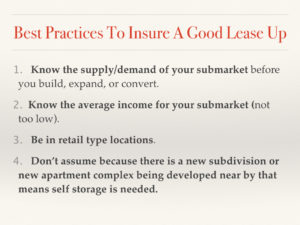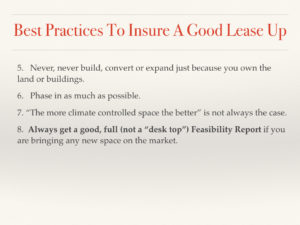There is no question about it. The self-storage industry has experienced a construction boom.
As of Sept. 2018, units planned or under construction account for 9.3% of the existing inventory in the U.S. according to Yardi matrix.
The most active markets amount the 31 major metro areas for self-storage development according to Yardi were Nashville, TN; Portland, OR; Boston, MA; Raleigh-Durham, NC; and Orlando FL.
The markets of the 31 with the lowest development activity were San Francisco, Los Angeles, and California’s Inland Empire. This is mostly due to land use limitations and approval barriers.
How Fast Will It Lease Up?
In the past, we have been hitting or exceeding our lease-up assumptions easily. Most of us did.
Our practice was to assume around 1,200 to 1,500 net square feet per month lease up absorption, then adjust it based on the results of a feasibility report.
It has always served us well. In most cases, we exceeded the lease up. In some cases, significantly.
All it takes is one or two projects to lease up slower than the Proforma to bring humble you.
In reality, so many factors go into what actually creates demand and absorption for any given market, it is hard to determine with accuracy what lease-up will really be. All a person completing a feasibility report can do is to use the historical lease up information they gather, and make some adjustments for current market conditions.
In our case, we do mostly expansions or conversions. This means we can hit the market much faster from the time of the feasibility report completed than new construction from the ground up. It is usually just a matter of a few months from the time the feasibility report is completed to the time we are leasing.
In new construction, we have learned the hard way, it can be a year and a half to two years in some cases, between the report and lease-up commencement.
A lot can happen in a year or two within a submarket that could effect lease up.
In most cases, for a larger facility, 50,000 square feet or more, it will take 2 to 4 years to hit stabilized occupancy if everything goes right.
If things slow down it can take longer. In some cases, much longer.
What are some of the factors that affect a submarket that can slow down lease up? Here are a few we have experienced:
- More self-storage from new construction and expansions of existing facilities.
- A major employer leaves or lays off workers.
- Average income per person or per household is going down.
- Population growth is flat or negative.
- Lots of newly immigrated people included in the population numbers (they have little need for self-storage until they have assimilated into the population and have created net worth).
When I hear people say “I’ll lease it up in a year” I cringe. I have heard myself say similar things before.
Not now.
A Successful Lease UP
Here are some factors that will increase your odds of a successful lease up.

- Know the supply/demand of your submarket before you make a decision if you will build, expand, or convert.
- Know the average person’s income for your submarket. Do not go into a market with low income. Even if they lease from you, they do not stay as long. You will have a higher turnover, more collections, and generally, burn way more calories per dollar of income than you need to.
- Be in retail locations. Don’t assume you can drive traffic through marketing or websites. Even if you do, you will have to discount to get them there.
- No longer are self-storage facilities in industrial parks, inside neighborhoods, or not visible from a major road relevant facilities for consideration.
- Don’t assume because there is a new subdivision or new apartment complex being developed nearby that means self-storage is needed.
- Let’s assume that a new 400-unit apartment complex is under construction in your submarket. Let’s say the average is 2 people per unit. Let’s also say the submarket has a high average number of square feet per capita, 7. Here is the math:
- 400 x 2 = 800
- 800 x 7 =5,600
- The maximum that apartment complex could affect your facility is 5,600 square feet of demand. In reality, it will be between 1,000 and 3,000 square feet rented from the apartment residences if everything goes right. And 400 units is a large apartment development.
- Let’s assume that a new 400-unit apartment complex is under construction in your submarket. Let’s say the average is 2 people per unit. Let’s also say the submarket has a high average number of square feet per capita, 7. Here is the math:
- Never, never build, convert or expand just because you own the land or buildings. Always know if there is unmet demand. Only then add more space in a submarket.
- Phase in as much as possible.
- Always try not to be too ahead of the market with your storage. Yes, I know it cost slightly less to build it all at once and construction managers push you to do so; but realize that if you have to pay interest on empty units for a prolonged period of time, that cost will dwarf any little bit of savings you got from building it all at once. You can also get parking income on the area where more units will go while you lease up your constructed space.

- Always try not to be too ahead of the market with your storage. Yes, I know it cost slightly less to build it all at once and construction managers push you to do so; but realize that if you have to pay interest on empty units for a prolonged period of time, that cost will dwarf any little bit of savings you got from building it all at once. You can also get parking income on the area where more units will go while you lease up your constructed space.
- “The more climate controlled space the better” is not always the case.
- In many submarkets, climate controlled space will lease up much slower than non-climate controlled space. As enticing as that 25% to 35% additional income is that climate controlled space offers, know if the submarket likes it, will rent it and will pay the premium climate controlled space usually offers. I can’t tell you the number of facilities I look at in which the price difference between climate controlled and non-climate controlled is the same or very close. That was a mistake. Too much climate-controlled space.
- How will you know? Yes, that’s right, a Feasibility Report. Which leads into…
- Always get a good, full (not a “desktop”) Feasibility Report if you are bringing any new space on the market.
I am sharing from experience here of not doing the above best practices at times in my self-storage career. Nothing is more humbling than having a project take longer than you thought it would as you talk to your partners and lenders.
If you adhere to these best practices, the chances of your lease up doing well are increased 100 fold.
Don’t be afraid to build, expand or convert. Just do so strategically and know your market and your numbers. If you do that, you can experience the freedom, cash flow, and wealth self-storage can offer the smaller investor.
It is still the best game in town.



